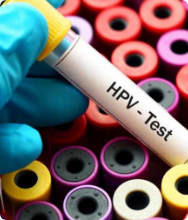
Book a Consultation
Thank you!
Your form has been sent successfully.

The cervix is located in the lower part of the uterus and forms a canal between the uterus and vagina. As per a study published by Cancer.net, in 2020, approximately 604,127 women were affected with cervical cancer around the world. Different variants of the human papillomavirus (HPV), which is spread via a sexually transmitted infection, are responsible for causing cervical cancer. Cervical cancer treatment consists of various procedures. If detected at an early stage, it can be successfully treated.
There are two types of cervical cancer:

It originates in the squamous cells of the tissue covering the outer part of the cervix. These cells are flat, thin, and look like fish scales. It is the most common type of cervical cancer and as reported by The American Cancer Society, accounts for approximately 90% of diagnosed cases.
It affects the glandular cells that release mucus and cover the upper region of the cervix. Compared to squamous cell cancer, adenosquamous carcinoma is a less common type of cervical cancer. It accounts for about 20% of all cases.
A person having cervical cancer can experience any of the following symptoms:
 Foul-smelling vaginal discharge that can be bloody or watery
Foul-smelling vaginal discharge that can be bloody or watery
 The menstrual cycle is longer and heavier than usual
The menstrual cycle is longer and heavier than usual
 Pain or bleeding during and after intercourse
Pain or bleeding during and after intercourse
With the advancement of technology and science, fortunately, the treatment options for cervical cancer are wide-ranging. However, the doctor chooses the most effective treatment protocol after considering two critical factors: the stage as well as other symptoms that the patient is experiencing.

Surgery is performed if the disease is detected at an early stage. It involves removing the tumor and some of the healthy tissues surrounding it. Surgical procedures are again categorized into different types:
High-intensity energy beams like X-rays or protons are directed toward the cervix to destroy the cancerous cells. Sometimes it is also combined with chemotherapy to increase the efficacy of the treatment process.
Cervical cancer treatment comprising targeted therapy uses drugs to focus on destroying the proteins, genes, or tissues that aid in the growth of the cancer cells.
In this type of treatment, drugs are given to boost the patient’s immune system to fight the disease more effectively.
It is another treatment in which medications are injected intravenously or given orally to kill the cancerous cells. If the cervical cancer is at an advanced stage, chemotherapy can be given in combination with radiation for better results.
Doctors may recommend any of the following tests to diagnose cervical cancer:

A Pap test is done to identify any irregular or abnormal cells inside the cervix. The procedure involves gently scraping the cells inside the cervix and examining them to check for unusual growth.

The process is performed similarly to a pap test. The sample of cells inside the cervix is tested to detect any abnormal changes and find out the different strains of HPV. For instance, HPV16 and HPV18 are known to be the most dangerous Human Papillomavirus strains. An HPV test can be conducted simultaneously with a pap test or after.

This test is conducted with a special instrument known as a colposcope. In the colposcope, the cervix and vaginal cells appear to be magnified. It provides a magnified view of the cervix and vaginal tissues for a specialist to make an evaluation.

Different images of the cervix are taken using x-rays from various angles. The pictures are three-dimensional and help in identifying any abnormality or growth of tumors. A computed tomography (CT) scan also helps in determining the exact size of the tumor.

MRI or Magnetic Resonance Imaging is done to obtain high-resolution images of the organ or region of the body where cancer has spread. It is a non-invasive imaging test method that helps in the detection of disease, diagnosis, and in deciding the most appropriate type of treatment for the patient.
The specialists for cervical cancer at ACTC in Florida, offer outstanding patient care by prescribing personalized and evidence-based treatment plans tailored to individual patients' needs. We aim to foster a positive environment that focuses on physical and mental health throughout a cancer patient's journey.
The following are our providers who you can consult at ACTC:

Hematology/Oncology

Hematology/Oncology

Radiation Oncology

As one of Florida's leading advanced cancer centers, we understand how a cancer diagnosis and treatment impact a person's physical and emotional well-being. Therefore, we work hard to make patients with all forms of cancer and their families feel secure. We provide comprehensive treatment for carcinoid tumors at ACTC, including screening, diagnosis, staging, treatment, and long-term follow-up, all in one convenient location. Our physicians are backed up by qualified clinical staff with over two decades of experience and a reputation for providing individualized treatment.
Schedule a consultation by calling
 352-345-4565
352-345-4565
The early warning signs of cervical cancer are:
Almost all types of cervical cancer are caused by a high-risk strain of the human papillomavirus (HPV). There are more than a hundred different types of HPV strains but only two, HPV-16 and HPV-18, can cause cervical cancer. HPV can be transmitted via:
Cervical cancer occurs in the cervix which is located at the lower part of the uterus and connects to the vagina. Often, it spreads to other parts of the body (metastasis), such as the lungs, liver, bladder, vagina, and rectum. In some cases, cervical cancer can spread to lymph nodes in the area between the hips (pelvis). Lymph fluid can also be prevented from draining away if cancer cells are present in the body. This results in a fluid buildup that can cause swelling in the legs.
Schedule a consultation by calling
 352-345-4565
352-345-4565